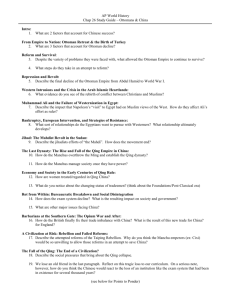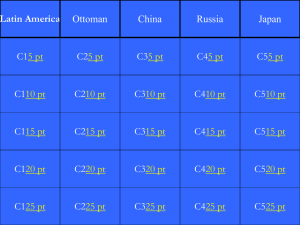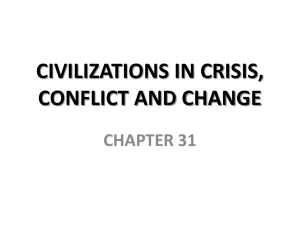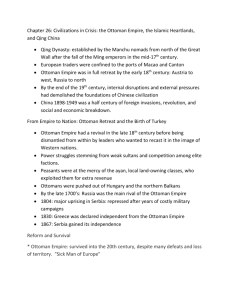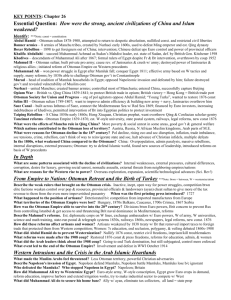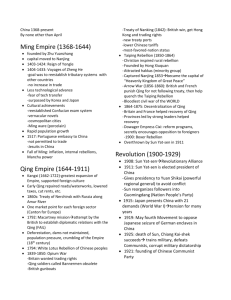CIVILIZATIONS IN CRISIS, CONFLICT AND CHANGE
advertisement
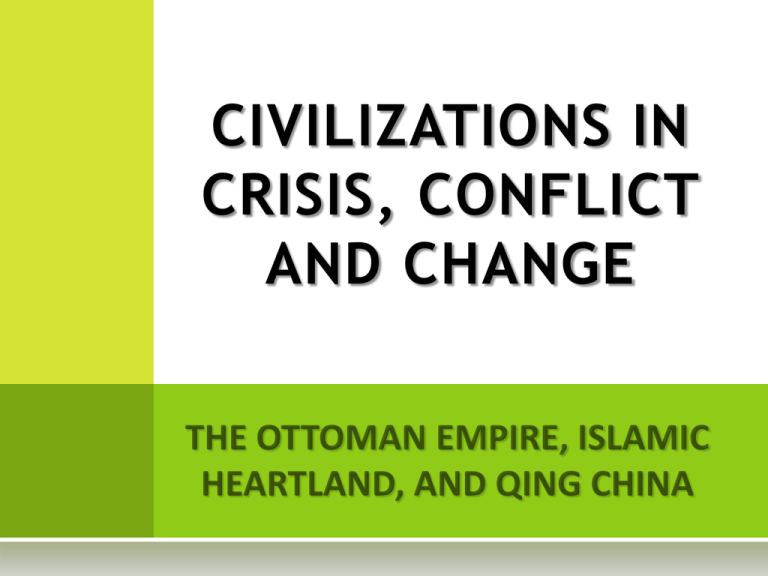
CIVILIZATIONS IN CRISIS, CONFLICT AND CHANGE EURASIA CIVILIZATIONS IN CRISIS: CHINA • The Problem for the Middle Eastern empires and Qing China – – • Internal Political Decline and inability to reform Western Intrusion economically, socially and politically 1750 – Manchu or Qing China • • • • • • Came to power in 1644 Manchu were last nomadic invaders to overrun a sedentary state Took name of Qing It appeared that China would recover fully under the Manchus Western merchants contained at the ports of Macao and Canton. 1850 – Manchu or Qing China • • • • • European military intervention exposed Qing dynasty as weak Vulnerable to external assault Internal disruptions swept away the imperial system of China, Little available to take its place Foreign forces competed for dominance in the wreckage of China EURASIA CIVILIZATIONS IN CRISIS: MIDDLE EAST • The Problem for the Middle Eastern empires and Qing China – – • Internal Political Decline and inability to reform Western Intrusion economically, socially and politically 1750 – The Muslim States in 1750 • Ottoman Empire seemed on verge of collapse in the 18th century – – – • • • Internal independence movements European encroachments Political disarray at Constantinople India, Persia weakening and increasingly under pressure from West Egypt was part of Ottoman with similar internal, external problems 1850 – – Persia changed dynasties but made little progress The Ottoman Empire recovered from is 18th-century malaise. • • • • Much of the Middle East was lost Turkish reformers overthrew the sultanate Quickly reformulated a new government Egypt had attempted to break away, reform only to be defeated OTTOMAN PROBLEMS • The Ottoman Empire depended on capable sultans – – – – • Economic Decline – – – – • The quality of rulers declined Internal disintegration was rapid Factional struggles within the palace common Corruption of provincial officials paralyzed government. Competition with European imports hurt Destroyed the market for Ottoman products Urban artisans rebelled. Ottomans increasingly dependent on European goods External Pressure – – – – Was severe – European armies modern, powerful Habsburg Empire and Russia seized territory Independence movements in the Balkans arose Distant provinces ignored, threw off Ottoman rule REFORM AND SURVIVAL Britain as savior Reforming Sultans Britain, France intervene in Crimean War Prevented Russian access; saved the Ottoman Empire from collapse Sultan Selim III Tried to enact military and administrative changes Angered the Janissaries, who overthrew him in 1807. Sultan Mahmud II Janissary conservatism led Sultan to destroy corps in 1826. Created a diplomatic corps, westernized remaining military forces Tanzimat reforms from 1839 to 1876 Westernization was introduced to other facets of Ottoman society University education was reorganized Postal, telegraph systems introduced; newspapers were established Legal reforms were mandated New constitution along Western lines appeared in 1876 Considered the culmination of the reforms. Artisans suffered from the opening of the empire to Western trade Women gained little from the reforms THE CHANGING OTTOMAN MAP REPRESSION AND REVOLT • Reaction – – – – – • The reforms produced a Western-educated elite Many came to view the sultanate itself as archaic Increasing Turks see Sultan as anti-modern Sultan Abdul Hamid reacted by nullifying the new constitution Imprisoned many of the Western-oriented elite Young Turks – – Resistance to Abdul Hamid's reactionism led to his overthrow in 1908 Young Turks • • • • • – – – • A group of military officers seized the government Leader was Mustapha Kemal, Enver Pasha Restored the constitution and promised additional reforms The sultan was reduced to a powerless religious figurehead The officers proved no more successful than the sultans At first, emphasized an Ottoman nationality Increasingly emphasized a Turkish nationality over all others Arab portions of empire became increasingly resistant to Turkish rule Turkey In World War I – – – Turkey participated in World War I on the side of the Germans Initiated the final dissolution of the Ottoman Empire Allies supported Arabs, Greeks, Armenians and partition HOW EUROPE VIEWED THE OTTOMAN EMPIRE Change of Clothes Butcher, 1st Class MEHMET ALI OF EGYPT • Mehmet (Muhammad) Ali in Egypt Albanian Ottoman governor of Egypt Enabled him to ignore the Ottoman sultan and function independently • • • Goals • • • • • Introduce a European style state Reorganize Egyptian society, modernize Egyptian economy Train a professional western-style bureaucracy Build a western style military Muhammad Ali’s Reforms • • • • • • • Nationalized all land in Egypt, raised taxes throughout Egypt Declared trade a state monopoly: established a textile industry Introduced production of cotton as way to boost state wealth, influence Boosted wages for workers, farmers enormously Introduced corvee system on peasants to obtain labor: very unpopular Built a preliminary industrial base to support his army and navy Sent promising students to study in Europe and hired European advisors • Muhammad Ali’s Foreign Policy • Modern army and navy threatened Ottomans and many European powers • Muhammad Ali extended his control to Arab Syria, Holy Cities, Sudan • Ottomans asked him to put down Greek Rebellion in 1820s • Egypt intervened, which prompted European navies to destroy his fleet, army • Later war with Ottomans over Syria prompted European intervention again Later years saw his reforms collapse • IMAGES OF MUHAMMAD ALI’S EGYPT EGYPT • Muhammad Ali’s Khedive successors • Muhammad Ali's successors continued his general plans with disastrous results – – – – • By the middle of the 19th century – – – • Cotton production expanded at the expense of food products. As a single export commodity, cotton vulnerable to price, demand swings in world market Educational reforms were limited to the elite The general population barely profited from the reforms. Khedives were heavily in debt to European creditors Europeans were attracted to Egyptian cotton and the plan to construct the Suez Canal Islamic intellectuals met in Egypt to discuss means of expelling the European threat » Some argued for strict Islamic religious observance » Others for greater Westernization in science and technology » The two groups were unable to reconcile their different approaches. Building the Suez Canal • Ferdinand de Lessups • • • • • French engineer convinced Khedive to build canal linking Mediterranean, Red Seas Modern technology made it possible Opened 1869 to much acclaim Khedives squandered wealth from canal, increasingly in debt to westerners French and British investors – – – – – Held the majority of shares in the Suez Canal Urged their governments to intervene directly in Egypt An Egyptian army rebellion under Ahmad Orabi British send military units to Egypt in 1882 Thereafter the administration of Egypt was in the hands of British consuls. THE SUEZ CANAL THE SUDAN • Egypt and the Sudan • • • • • Resistance and Revolt • • • • • • • Resistance to Egyptian and British influence was focused by Muhammad Achmad He was head of a Sufi brotherhood in the Sudan Took title of Mahdi, claimed descent from Muhammad, declared a jihad He offered to purge Islam of foreign influences and restore purity Military forces of the Mahdi enjoyed military success against Egyptians His role as leader of the Sudan insurgence was taken by Khalifa Abdallahi British Respond • • • • • • Egyptian forces long engaged in attempts to extend control down the Nile River The khedives enjoyed little success Their control was limited to towns such as Khartoum Attempts in the 1870s to eliminate the slave trade added to discontent British expeditionary force defeated the Mahdist army in 1898 The British thus extended their power along the Nile Much Islamic territory passed under control of Western forces during 19th century Neither reformers and religious revolutionaries were able to slow the process Could not halt it entirely Islamic civilization became increasingly anxious over its fate CHARGE OF THE DERVISHES AT OMDURMAN THE MANCHUS • Nurhaci – – – – • 1644 – – – • Local Chinese official invited the Manchus within the Great Wall Nomads advanced, captured the Beijing in 1644 The Manchus were able to establish a new dynasty The Qing – – – – • Able to unite the Manchu nomads Created eight banner armies Introduced Chinese administrative reforms into government Called his dynasty Qing The Qing incorporated much of former Ming including scholar-gentry Direct role appointment of local officials Ethnic Chinese continued to be admitted into imperial government Manchus, unlike Mongols, retained civil-service examination system. The Qing Sons of Heaven • • • The first Qing rulers were models of Confucianism Generous patrons of the arts Kangxi was both a patron and a scholar MANCHU SOCIETY • Manchus preserved the Confucian social hierarchy – – – – • Gender – – – – • Wives chosen from one social rank lower than husbands Women subject to patriarchal authority in home They might gain some control over household activities Female infanticide seems to have increased The Peasants – – – – – – • Neo-Confucianism was the predominant philosophy 5 Relationships emphasized in education, imperial edicts Family remained at the core of society Secret societies and innovation viewed with suspicion Qing attempted to relieve distress among peasantry Initially lowered taxes and labor demands 10% of imperial budget went to maintaining infrastructure Population pressures made their efforts virtually useless Value of labor fell Rural landlords gained stranglehold over rural economy Commerce and the City – – – – Commercial, urban expansion continued under the Qing Profits from exports produced new group of merchants Called compradors, they specialized in silk exports Also worked in Canton with foreigners as middlemen QING CHINA: CANTON TRADE BREAKDOWN, DISSINTEGRATION • By the late 18th century – Corruption riddled civil-service – – – – Wealthy families • • • Used bureaucracy as means of establishing local authority. Revenues diverted from state to enrich bureaucrats Spending on military, public works projects declined – – – – • Cheating common on the civil service exam Rise of uneducated bureaucrats hurt government Posts became hereditary or available for purchase Decline in competency of the military Floods wiped out some of most productive farmland Food shortages produced peasant migrations Rise of banditry and homeless populations Problems were of such scale that the normal cycle of dynastic decline and replacement was threatened. OPIUM WAR OPIUM WAR AND AFTER The Westerners are Coming, the Westerners are Coming! A new type of barbarian, the Europeans, threatened China In the 1830s Emperor appointed Lin Zexu to stamp out opium trade Lin blockaded Canton and confiscated European opium supplies. British merchants demanded their government intervene to protect profits In 1839 British plan to export opium from India to China Wanted to improve their balance of trade (stop loss of silver) Qing recognized threat to its economy and its society British routed the Chinese junks in the first stages of the Opium War. British sent a military force ashore, the Qing emperor sued for peace. British obtain Hong Kong Forced China to open ports to trade , recognize extraterritoriality of foreigners By the 1890s 90 Chinese ports open to European, Japanese, American merchants Britain, France, Germany, Russia leased certain ports, hinterlands Trade passed increasingly into the hands of the non-Chinese Qing court was forced to accept European diplomats. PARTITIONING CHINA AND THE BOXER REBELLION FAILED REFORMS Defeat by the British helped to set off series of rebellions against the Qing The Taiping Rebellion: 1850s and 1860s Self-Strengthening Movement French in Indo-China 1885 and British in the Arrow War 1860s Sino-Japanese War in 1895 The Dowager Empress Cixi Manchus continued to obstruct almost all programs of reform Defeats by Europeans and Japanese continue Provincial leaders began to carry out much needed reforms Built railways and factories, modernized military Resources moved from the central court to the provinces Qing Reaction A semi-Christian movement under a prophetic leader, who wanted Land redistribution and the liberation of women End to influence of the Confucian scholar-gentry Provincial forces finally defeated rebellion; more than 50 million dead in civil war Cixi assumed regency for her son, grandson – refused all attempts at reform Supported Boxer Rebellion as means of ousting foreign influence. Boxer Rebellion Society of Righteous and Harmonious Firsts Anti-modernization, anti-westernization forces in country side Attacked western built technology , missionaries, diplomats in Beijing Europeans, US, Japanese intervene to rescue diplomats Forced China to accept Western control and intervention in their society, politics TREATY PORTS AND REBELLIONS IN QING CHINA LATE QING REBELLIONS FALL OF THE QING Resistance Resistance to the Qing centered in secret societies Goals Western educated doctor became a leader of China after 1911 Revolution Sought to build a Chinese nation-state on a western model Favored wide-spread social reforms especially for peasants and workers 1911 Revolution Drew on Western ideas for a reformed government Wanted to restore Chinese territorial integrity, expel foreigners from their soil Sun Yat Sen Sponsored local uprisings against the central government Western-educated compradors and some scholar-gentry involved Widespread uprisings throughout China by the secret societies Could not be put down by provincial officials Military often joined rebellion in open mutiny In 1912, the last Qing emperor, Puyi, a boy of 12, abdicated Prior to abdication Qing had abandoned Confucian examination system Abandonment of examinations signaled end of patterns in China IMAGINING THE 1911 REVOLUTION GLOBAL CONNECTIONS • Muslims – – – – • China – – – – – – • Long accustomed to the military threat posed by the West. Could justify some borrowing from West on basis of a shared JudeoChristian , Greek heritage More politically fragmented than Chinese but Muslims had time to learn from early mistakes. Muslims could always fall back on religious faith as a last resort. West's military dominance came as a rude surprise. China had remained intentionally culturally isolated from the West. They regarded Western culture as barbaric. Chinese equated survival of civilization with maintenance of the Qing When the dynasty collapsed, Chinese civilization was destroyed. Chinese had no great religious tradition to counter European belief in its inherent superiority. Versus Other Lands – China and the Ottoman Muslim lands differed from Africa • • – Differed from Latin America • • – They were only partially colonized Often able to maintain independence and seek own internal reforms Which had deeper ties to the West Attempted economic modernization, westernization Differed from Russia and Japan • • Which industrialized and which maintained independence Both also partially westernized WHAT IS IT? TAIPING REBELLION TANZIMAT REFORMS SUEZ CANAL OPIUM WARS SELF-STRENGTHENING MOVEMENT BOXER REBELLION EXTRATERRITORIALITY TREATY PORTS OPEN DOOR POLICY WHO ARE THEY? YOUNG TURKS MUHAMMAD ALI (MEHMET ALI) KHEDIVES AL AFGHANI THE MADHI NURHACI MANCHUS/QING COMPRADORS COMMISSIONER LIN HONG XIUGUAN SUN YAT SEN
